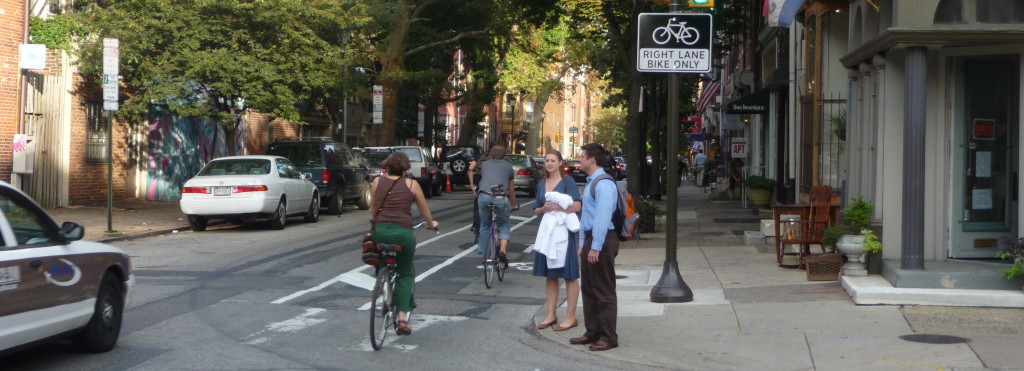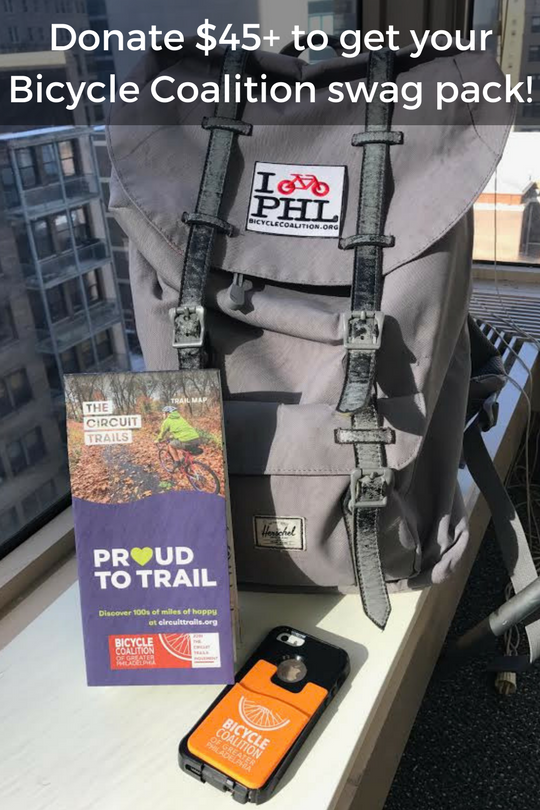
Remember the 2000s? Dane Cook? Razor scooters? Freedom Fries?
Well, we remember. And in the 2000s we weren’t really thinking about Bro Comedy and ways to clog-our-arteries-while-being-passive-aggressive-toward-an-entire-country so much as we were a citywide bicycle action plan.
At Mayor John Street’s request, we put our minds together for an official Philadelphia Bicycle Action Plan, which would call for the appointment of a bike coordinator, a bike network, a bike station at JFK Plaza, a bike parking program, and the promotion of more bike tourism in Philadelphia by 2005.
Throughout the process and into the decade, Philadelphia would become known nationwide as a city good for bicycling. And to commemorate that, we’ve got a swag pack this week for anyone who gives a $45 tax-deductible gift or becomes a member at $45. It comes with a Bicycle Coalition custom phone wallet, an “I Bike PHL” patch, and a Circuit Trails map!
With that new plan came heightened recognition. The Bicycle Coalition of Greater Philadelphia was finally being recognized as an official player in city planning after working to have an impact throughout the 70s, 80s, and 90s.
“Thanks to those who came before us, bicyclists now have a seat at the table with other transportation planners,” noted new BCGP President Parker Snowe in a 2002 Cyclegram. “Now it is time for us to use this position to ensure that promises made are promises kept.”
Later that year, the Bicycle Coalition would launch its Bicycle Education and Enhancement program with the Philadelphia School District, teaching children in 18 local schools bike safety and etiquette.
By 2004, it was time for the Coalition to hire a new Executive Director, and the Board of Directors began a fundraising campaign to raise $30,000 to do just that. Alex Doty was later hired as Executive Director as Philadelphia’s bike lane mileage reached 200 miles.
In 2007, after years of negotiations, the CSX railroad company announced that the entrances to Schuylkill River Park at Locust and Race Streets would stay open. The company had been previously trying to shut down those entrances.
The next year, the Bicycle Coalition published its ”Double Dutch: Bicycling Jumps in Philadelphia,” which showed our 2008 bicycle counts conducted by Bicycle Coalition staff and volunteers.
Those counts found bicycling had jumped 104 percent in the previous three years, or about 35 percent per year. This happened as we continued to push for a better South Street Bridge, which was still being constructed.
And although bicycling was continuing to jump in the city, non-cyclists would continue complaining of cyclists’ behavior, due to this new rise of Philadelphia as a cycling city.
A year later, in 2009, the city would install the first 10-foot bike lanes in Center City, along Spruce and Pine Streets. These lanes would quickly become the most-cycled in the city, and the ire of some city residents who don’t believe cyclists have the same rights as everyone else.
This would begin Philadelphia’s first “Great Bicycle Debate,” as it was called in the Bicycle Coalition Office at that time—with Spruce and Pine Streets serving as Ground Zero—and that debate is still ongoing.

